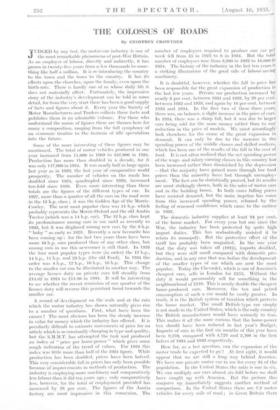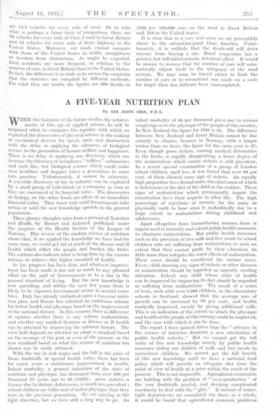THE COLOSSUS OF ROADS
By GEOFFREY CROWTHER JUDGED by any test, the motor-car industry is one of the most remarkable phenomena of post-War Britain. As an employer of labour, directly and indirectly, it has grown in twenty-five years from a few thousands to some- thing like half a million. It is re-introducing, the country to the town and the town -to the country. It has its effects upon the churches, upon the family, even upon the birth-rate. There is hardly one of us whose daily life it does not materially affect. Fortunately, the impressive story of the industry's development can be. told in some detail, for from the very start there has been a good supply of facts and figures about it. Every year the Society of Motor Manufacturers and Traders collects these facts and publishes them in „an admirable volume. For those who understand the music of figures there are themes here for many a composition, ranging from the full symphony of an economic treatise to the fantasia of idle speculation into the future.
Some of the more interesting of these figures may be mentioned. The total of motor vehicles produced in one year increased from 11,000 in 1909 to 342,000 in 1934. Production has more than doubled in a decade, for • it Was only 147,000 in 1924. It was nearly half as large again last year as in '1929, the last year Of comparative world prosperity. The number of vehicles on the roads has doubled since 1924, quadrupled since 1920, • increased ten-fold since 1910. Even more interesting than these totals are the figures of the different types of car. In 1927, more than a quarter of all the cars on the road were in the 12 h.p. class ; it was the Golden Age of the Morris- Cowley. The next' most popular class was 14 h.p. which probably represents the Morris-Oxford and the old Austin Twelve (which was a 14 h.p. car). The 12 h.p. class kept its predominance among cars in use until as recently as 1988, but it was displaced among new cars by the 8 li.p. " baby ",as.early. as 1929. Recently a new favourite has been coming up : for the last two years there have been more 10 h.p. cars produced than of any other class, but among ears in use this newcomer is still third. In 1926 the four most popular types were (in 'order) the 12 11.p., 14 h.p., 11 h.p. and 23 h.p. (the old Ford). In 1934 the order was '8 h.p., 12 h.p., 10 h.p., 16 h.p.- This change to the smaller car can be illustrated in another way. The 'average licence duty on private cars fell steadily from £14.62 in 1924 to £11.90' in 1984. • It will be interesting to see whether the recent remission of one quarter of the licence duty will reverse this persistent trend towards the Smaller car: 'A record of development on the scale and at the rate which the motor industry has shown naturally gives rise to a number of questions. First, .what have been the causes ? The most obvious has been the steady increase in value for money which the industry has offered. It is peculiarly difficult to estimate movements of price for an article which is so constantly changing in type and quality, but the S.M.M.T. has attempted the task and produced an index of " price per horse-poiver " which gives some ;rough indication of the trend of values. For 1934 this index was little more than half of the 1924 figure. While production has been doubled, prices have been halved. This very considerable fall in prices has only been possible because of improvements in methods of production. The industry is employing more machinery and comparatively less labour than it did ten years ago ; only comparatively less, however, for the total of employment provided has increased by 28 per cent. The figures of the Austin factory are most impressive in this connexion. The number of employees required to produce one car per week fell from 55 in 1922 to 8 in 1934. But the total number of employees rose from 3,200 in 1922 to 16,000 in 1934. The history of the industry in the last ten years is a striking illustration of the good side of labour-saving • machinery.
It is doubtful, however, whether the fall in price ha.1 been responsible for the great expansion of production in the last few years. Private car production increased by nearly 8 per cent.. between 1931 and 1932, by 29 per cent: between 1982 and 1933, and again by 16 per cent. between 1933 and 1934. In the first two of these three years, there was, on balance, a slight increase in the price of ears: In 1934, there was a sharp fall, but it was to 'larger ears being sold for the same money rather than to any reduction in the price of models. We 'Must accordingly look elsewhere for the cause of the great expansimi iii demand. It can only be due to the increase' iii the spending-power of the middle classes and skilled workers, which has been one of the results of the fall in' he cost of food. It is not often realized that the net spending-power of the wage- and 4alaryearning classes in this country has been increased rather than diminished by the depression —that the majority have gained more through low foOd prices than the minority have lost through Unemploy- ment. The fact can be statistically proVed, but its results are most strikingly shown, both in the sales of motor ears and in the building boom. In both' cases 'falling prices have assisted demand, but the main, impetuS has comae from this increased spending power, releaSed' by the feeling of renewed confidence' which came to' the surface in 1982.
The domestic industry supplies at year 94 per Cent. of the home market. For every year bUt one since the War, the industry has been protected by. quite high import duties. .This has undoubtedly assisted it to retain its monopoly. But the protective' effeet of the tariff has probably been magnified. In 'the' one year that the duty was taken off (1920), imports doubled, but they were still small compared with doinestic pro- duction, and in any case that was before the development of the smaller types of car which are now the most popular. Today the Chevrolet, which is one of America's cheapest cars, sells in London for £255. Without the duty it would presumably sell for something in the neighbourhood of £210. This is nearly double the cheapest home-produced cars. Moreover, the tax and petrol consumption of such a car would be vastly greater. In truth, it is the British system of taxation which protects the home market. The small British-type ear simply is not made in the United States, which is the only country the British manufacturer would have seriously to fear. This makes it all the more curious that the horse-power tax should have been reduced in last year's Budget. Imports of cars in the first six months of this year have been 9,270, compared with 4,729 and 2,108 in the first halves of 1934 and 1933 respectively.
How far, as a last question, can the expansion of the motor trade be expected to go ? At first sight, it would appear that we are still a long way behind America. We have one private motor ear in use for every 84 of the population. In the United States the ratio is one in six. We can multiply our ears almost six-fold before we shall have caught up with America. But the picture this conjures up immediately suggests another method of comparison. In the United States there are 7.8 motor vehicles for every mile of road ; in Great Britain there are 13.5 vehicles for every mile of road. Or to take what is perhaps a fairer basis of 'cOMparison, there are 70 vehicles for every mile of Class I road in Great Britain and 66 vehicles for every mile of State highway in the United States. Moreover, our roads cannot compare with 'those of the United States in width, straightness or freedom from obstruction. As might be expected, fatal aceidents are more frequent, in relation to the 'number of cars, in Great Britain than in the United States. In fact,the difference is so wide as to arouse the suspicion that the statistics are compiled by different methods. Por what they are worth, the figures are 309 deaths in 1983. per 100,000 cars on the road in Great Britain "and 129 in the United States.
It is clear that in a very real sense we are perceptibly Closer: to the saturation-point than America. Unfor- tunately, it is unlikely that the death-roll will deter anyone from buying a' car. Road congestion has a greater, but still rather remote, deterrent effect. It would be unwise to assume that the number of ears will auto- matically adjust itself to the adequacy of the road system. We May soon be forced either to limit the number of cars or to reconstruct our roads on a scale far larger than has hitherto been contemplated.



































 Previous page
Previous page